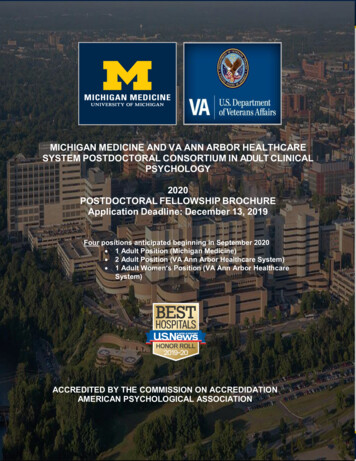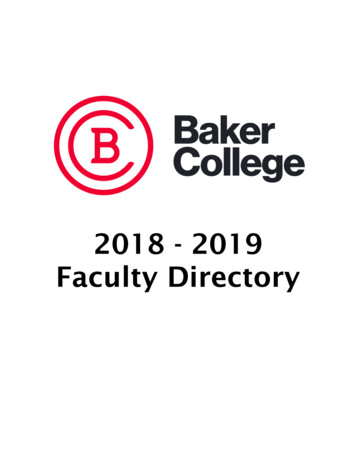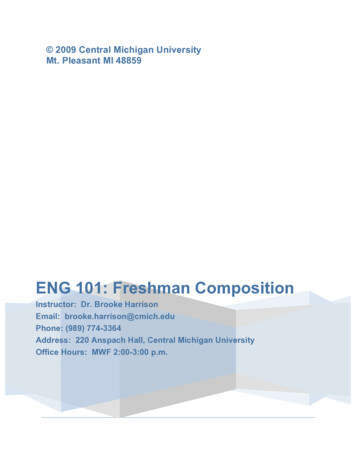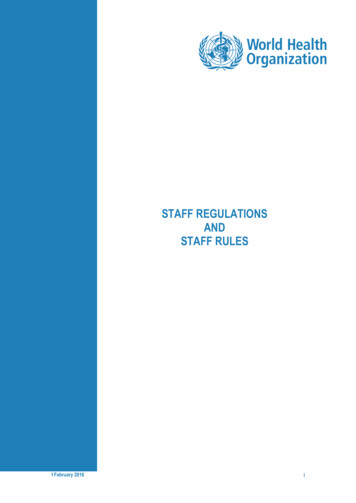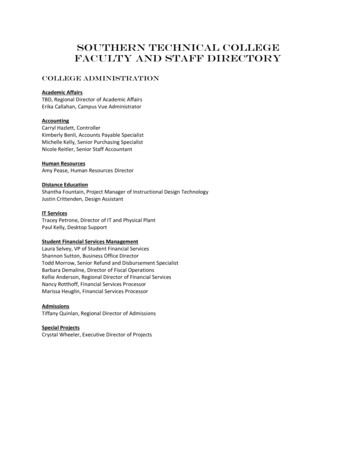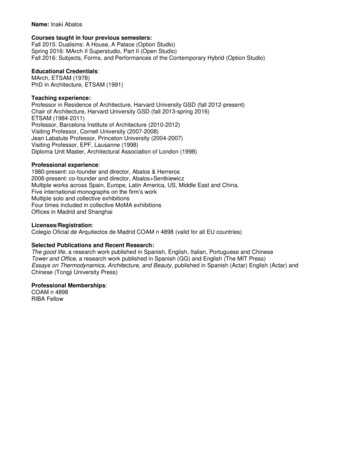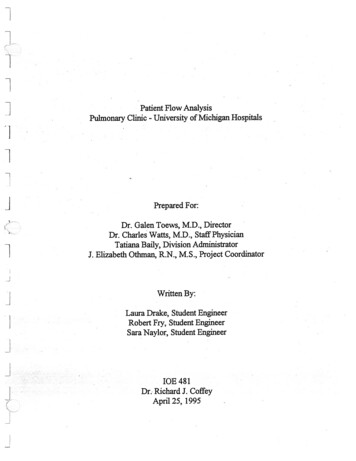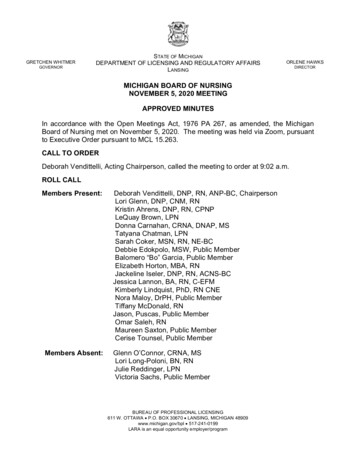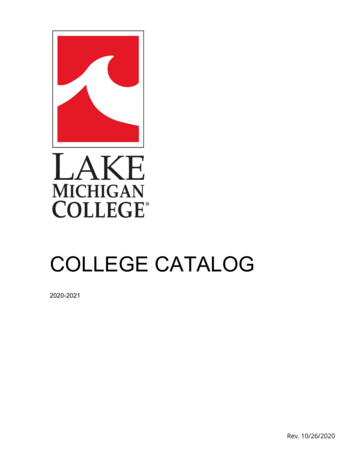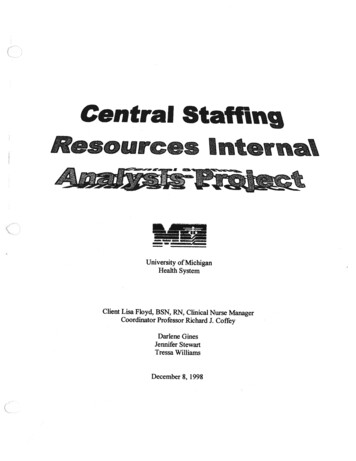
Transcription
Central StaffResources Intevna——University of MichiganHealth SystemClient Lisa Floyd, BSN, RN, Clinical Nurse ManagerCoordinator Professor Richard 3. CoffeyDarlene GinesJennifer StewartTressa WilliamsDecember 8, 1998
Central Staffing ResourcesInternal Analysis ProjectTABLE OF CONTENTSPageExecutive Summary1Introduction2Background2Purpose and Objectives of Project3Approach and Methodology3Current ion Plan11Contacts12Appendices17List of FiguresFigure1. Overall Percent of Followup Calls52, Number of FTE’s By Task3
Executive SummaryThe Central Staffing Resource (CSR) department, which is responsible for schedulingapproximately 870 people including both full time and temporary employees, is currentlyoperating under an inefficient and time-consuming system. The Industrial and OperationsEngineering 481-student team from the Programs and Operations Analysis (POA)Department studied this area in order to come up with recommendations that would reducethe amount of repetitive tasks and the number of scheduling errors through processimprovements. In addition, the team was called upon to provide the department with thenumber of administrative assistants needed to satisfy the mission of the CSR department.The key steps to our approach included interviews, observations, follow up call datacollection, and a workload analysis.The team found a number of key findings, which lead to several important recommendations: Although the CSR administrative assistants felt that follow up calls take up a lot of time;the collected data reflected the contrary. The data showed that about 72% of calls arefinished with the first phone call. The scheduling process is inefficient and leads to repetition of tasks. Communication between the CSR and unit administrative assistants needs to be improvedin order to reduce the amount of time spent scheduling. The work environment is congested at times, which is a distraction when theadministrative assistants are trying to work.Recommendations for the CSR are as follows: One new employee needs to be hired to fulfill the current workload of the CSR. A common database for scheduling may help to alleviate the problems with performingsimilar tasks a multiple amount of times. Before a database can be installed in the CSR office some upgrades should be done to thecomputers. The units should be encouraged to email information to decrease the amount of phonecalls. The task of updating of all Personnel files can be handle by one person instead of by allthe administrative assistants.CSR department needs to investigate whether or not more CSR staff (nurses, nursingassistants, patient attendants, medical assistants and clerks) are needed, by reviewing thenumber of request that are not met each week.
[introiuctionThe mission of the Central Staffing Resource (CSR) department is to supplement regulardecentralized staffing at the University of Michigan Health System using centralized, highquality, cost effective resources. The CSR department is responsible for scheduling 870nurses, nursing assistants, patient attendants, medical assistants and clerks in 100 clinics and50 inpatient units. The purpose of this project is to analyze workload of the CSRadministrative assistants and develop a plan to improve the distribution of work. It isbelieved that administrative assistants perform too many tasks and are unable to perform tolevel required for customer satisfaction.BackgroundThe CSR department began looking at the administrative assistants in the January1998term through the August 1998. The two main issues that came out of these studies wereinefficiency of the scheduling process and the large amount of daily phone calls.The previous study showed that 13 people spent a total of 1.54 FTE per day on the phone.Although 80% of the phone calls averaged less than a minute, it was believed that incomingphone calls led to many outgoing follow up calls to resolve an issue. Many incoming callsdeal with a need for a nurse, change in need, or a cancellation. Therefore an administrativeassistant has to make calls to the float nurses to either fill a need or inform them of acancellation.The scheduling process is very tedious and inefficient. The administrative assistantsinput the schedule into oversized scheduling books to create the monthly schedule. Then theymust manually match up the available nurses with the high priority units before putting theschedule in the Automated Nurse Scheduling Operating System (ANSOS).PersonnelThe project team consists of the project coordinator, Richard Coffey, and the teammembers Darlene Gines, Jennifer Stewart, and Tressa Williams. The client is the CentralStaffing Resources office at the University of Michigan Hospital and Lisa Floyd, BSN, RNManager. For a more detailed list/organizational chart of the members of the CSR Staff referto Appendices A1-A6.2
Purpose and Objectives of Project-The purpose of this project is to analyze the workload of the Central Staffing Resource(CSR) administrative assistants and develop a plan to improve the distribution of work. Theobjective is to have a reasonable amount of work for each assistant. It is believed thatadministrative assistants perform too many tasks and are unable to perform to the levelrequired to meet both customer satisfaction and the CSR Mission. For further information onthe CSR’s mission, goals and objective refer to appendix A7.[Approach and MethodologyKey phases are interviews, follow up phone call surveys, and workload analysis surveys.We studied the flow of the activities that go on in the CSR office in order to gain insightinto the possible inefficiencies and complications. This information serves as back upinformation to our data collected form the surveys.The follow-up surveys were done from October 16, 1998 to October 23, 1998 to capturethe amount of phone calls that result from one incoming call. A form was given to theadministrative assistants to mark each call that go in or out and whether it was the result of anearlier call. Refer to Appendix B 1 for an example of the form.The workload analysis surveys were performed for three weeks, October 26, 1998November 15, 1998. It captured scheduling, payroll, and regular weeks. The administrativeassistants were asked to wear beepers, which sounded randomly. At the time each beep theadministrative assistant checked the box for the specific task being performed. Through thisstudy we were be able to figure out how often a task is done and how many FTE’s are neededto perform each task. Copies of these forms can be found in Appendix B2-B4. Appendix B-5flowcharts the method used to determine FTEs.—Interviews were performed during the weeks of November 9, 1998 November 20, 1998.The purpose of the interviews was to determine how the administrative assistants felt abouttheir job. Interviews began with the simple question of whether the subject had any realconcerns about possible changes that could be made to his/her job. The administrativeassistants were asked two basic questions, which they were allowed to expand upon. Thequestions were as follows: “ What problems do you see with your job?” and “ Whatchanges would you suggest?” The subject was then shown the workload analysis resultscompiled during the previous study and asked if he/she felt that the analysis correctlycaptured their daily workload. The tasks that made up the majority of the subject’s workloadwere then discussed.—3
Current SituationThe CSR department’s administrative assistants are responsible for three main tasks.These tasks are the input and output processing of all employee information, compiling andupdating the schedule, and maintaining all payroll activities. Input and output processingincludes maintaining personnel files, mailboxes, inputting new hires into ANSOS system,updating the number of sick and vacation days allowed for each employee, and updatingemail lists. Currently there are approximately 50 new hires per month so these activities takeup a large amount of the administrative assistant’s time.The administrative assistants are responsible for three schedules. The first is a four-weekschedule. Temporary employees’ on the other hand, have no constraints on the number ofhours they are required to work. The temporary employees provide a list of days that theyare available at the beginning of each scheduling period. From this information, a four-weekschedule is compiled, inputted into the ANSOS system, and handwritten into a schedulebook. Units or clinics then submit requests to the CSR department using a four-weekschedule request form for the shifts that are understaffed. Most times the number of requestsis greater than the number of available CSR staff. The administrative assistants are thenresponsible for deciding which units have the most need and allocating staff to these units.Requests that are not filled are put on a wait list. All unit assignments for the CSR staff areinputted into the ANSOS system and a blue ‘A’ is put next to the shift in the schedule book.The ANSOS schedule is then printed out and matched with the schedule in the book to makesure that there are no errors. After everything is finalized the schedule is posted and a copyis given to all regular employees. CSR continues to try to fill all outstanding unit requestswhether they are previous requests or unanticipated add-ons. CSR administrative assistantsdo a weekly ANSOS update for the projected week on Fridays. Any new changes areentered into the ANSOS system and the schedule book. A daily schedule is also donebecause units are allowed to cancel up to 3 hours before the start of a shift. When acancellation occurs the administrative assistants are then required to call other units that haveoutstanding request and try to place that CSR staff.The last main task that the administrative assistants are responsible for is payroll. Thereare approximately 10,000 time card entries every two weeks. Each employee for every shiftfills out a time card in order to keep track of payroll and billing. Time cards are matched withthe ANSOS printout and then the assistants fill out a payroll sheet for each employee. Afterthe sheets are sent out, the administrative assistants receive a gross pay register. Theassistants match the payroll sheet to the register and make any necessary corrections. Referto Appendix Cl and C2 for flow charts of the activities.4
hidingsFollow up Phone Call SurveyThe Follow-up Phone Call surveys were conducted for one week from October 16,1998to October 23, 1998. As shown in Figure 1, 71.74 percent of calls were finished in just thefirst phone call. This means that the majority of incoming or outgoing calls are taken care ofwith the initial call. Our study contradicts the information given in interviews about thenumber of follow up phone calls. Appendix D contains a breakdown of the follow-up calldata by shift.Table 1. Follow-up Call 1249.00Overall Percent of Follow-up Calls80.0070.0060.0050.0040.00I10.000.001234567 Number of Follow-up CallsFigure 1. Overall Percent of Follow-up Calls5
InterviewsThe following is a summary of the findings that came from adminstrative assistant’sinterviews. There is an overall feeling within the office that a new system for schedulingneeds to be established. The current scheduling system is found to be confusing andinefficient. In addition, the scheduling system is found to be extremely tedious. Also throughthese interviews it was found that the payroll task are going to be assigned to two individualsand the other administrative assistants will no longer be responsible for payroll. Seven of thethirteen administrative assistants were interviewed.Problems as viewed by CSR administrative assistants: There is not enough *CSR staff to meet the needs of the units.Too much paperwork is required to prepare the schedule.There are too many ANSOS entry errors.The workload is too heavy for the administrative assistants.CSR staff overuse sick time.New employees are not trained well on ANSOS entries.The evening shift does not know or understand the tasks done by the day shift.Units do not know the appropriate person to call with questions and concerns thereforeadministrative assistants spend a lot of time transferring calls.Too much time is spent recruiting *CSR staff to fill emergency unit needs.Units do not understand the scheduling process of CSR.Setting up training program for nurses requires too much time.Units are allowed to cancel request for any *CSR staff up until 3 hours before shift startsToo much time is spent finding new assignments for *CSR staff due to unit cancellations.The high volume of phone calls is time consuming.Tasks are too repetitive.Too many meetings (personal or business) in the CSR office during shift changes, thesemeetings cause distractions and cause a high level of noise in the office.When calling units Administrative Assistants are put on hold for long periods of time(2- 5 minutes) before being able to speak with the appropriate person.Suggestions from CSR administrative assistants: Hire more *CSR staff.Schedule *CSR staff using 12-hour days. Improve the orientation of ANSOS system and schedule book Increase office space.Increase communication between units and CSR. Better communication between Administrative Assistants and Supervisors. Install an automated phone system to solve the problem of transferring calls Expedite scheduling request from units Provide Administrative Assistants on units with an orientation with how CSR works andallow them to work a day in the CSR office. Purchase a computer program that will allow all scheduling to be done on the computer.*csR staff refers to clerks, nurses, nurse assistants, medical assistants, and patient attendants.6
Workload AnalysisThe purpose of the workload study was todetermine whether or not more workers areneeded in the office. The analysis of theworkload data showed that 12.63 FTE’s wereneeded to perform all of the daily tasks. Thiswould show that it is not necessary to increasethe number of administrative assistants in theCSR office.However, analyzing the FTE’s on a shift byshift basis indicates the following: Six workers are required for the day shift. Four workers are required for the eveningshift. Four workers are required for the midnightshift.Refer to Appendix E for a detailed summary ofFTE’s by task, by person and overall.Table 2. FTEs By TaskTASKS (hoursldaj’f r4 FTE.ANSOS/daiIy.timpariPhone1.70CSR interactionOther1.04Staff interactionEmail0.76Pnonty/Schec1LiiejPayroll Weekend Support0.49Clerk Sched0.34Clerk Payroll0.29oPersonal0.25AnSOS/weekly timecards0.21JuteNurse Placement0.17Daily Sched Changes0.1Temp Bonus0.12NASched0.10Personnel paperwork0.09PA daily0.08E-mail recruit fill vac0.06PA Sched0.05Verify Med/Sur Schedule0.04F/U on SNcñiaLClerk GPR0.02NA WeeklyVac report e-mail0.02ACS Billing060Billing0.00NA dailyNurse GPR0.00Nurse Payroll BackupPost paper CSR UCs0.00Time Card on Pay Sheet0Time off request0.00UC Absence Report0.0Update Office Cheat Sheet0.00WC payroll grid12.63[LOTALFTES 7
CoLU0401.201.001.801I1IIIIIIiiI Iii ii iirhi:ii.ii.iiii riiiIlII 11iii:.ii;ini.riiTasksFigure 2. Number of FTE’s By Taskiii ki rii.iFull Time Equivalent By Task8
ConclusionsConclusions drawn from the interviews, workload analysis, and follow up surveys.The follow up surveys showed that the approximately 72% of all calls do not require afollow up. Follow up calls do not take up a large percentage of their time. The workload analysis survey showed that approximately 14 people are needed tocomplete the tasks required of the CSR department. Time management and workdistribution appears to be the problem rather than a shortage of personnel.Units need to give the CSR staff more advanced notice for cancellations. Moreover, theCSR department needs to make sure that all employees are dependable and are notmisusing sick and vacation time. These changes would decrease the number of changesmade to the daily schedule and would give the administrative assistants more time tocomplete other task A new computer program for scheduling would decrease repetitive tasks involved andincrease productivity. ANSOS is not effective for the CSR office because it does notallow access to more than one units’ screen at a time. Since the administrative assistantsschedule staff that works in multiple units, it is time consuming to continually switchscreens and manually retrieve information. If purchasing a new computer program is not possible the schedule book needs to bestandardized to eliminate confusion. In addition each administrative assistant needs to betrained on the system.Recommendations1. The workload survey showed that the number of administrative assistants needs to beincreased by one. One more employee would help to fulfill the current workload of theCSR. As the number of nurses employed by the CSR increases this may have to be reevaluted periodically.Tasks requiring the majority of FTEs should be reviewed for changes. These tasks are:ANSOS/daily time cards (1.71 FTEs), CSR Interaction (1.26 FTEs), and Phone Use (1.70FTEs). Suggestions for changing each of these tasks can be found in the followingsection under the action plan.2. A common database for scheduling may help to alleviate the problems with performingsimilar tasks multiple times. Having the scheduling data in a centralized pool will helpthe CSR and individual units cut down the time spent interacting because the databasewould become a centralized resource between the two. The database will also help to9
reduce the amount of time spent on paperwork and in learning the color-coded systemused in the scheduling books. The database needs to have a simple user-friendly graphicinterface and must also have fail safe measures to prevent data from being lost as data isshared and changed by more than one person.Microsoft Access and Oracle were both discussed as possible programs for an internaldatabase, which would unite the ANSOS (Automated Nurse Scheduling OperatingSystem) scheduling done by CSR and the units. Although MS Access is much more userfriendly than Oracle, the CSR should consider opting for Oracle or look into otherprograms such as MS d-Base. An article found in Computer World Newspaper’sthSeptember 25edition states that there is a problem with Microsoft Access that can leadto serious data integrity issues. The bug affects all versions of Access through the mostrecent Access 97. The crux of the bug is that the records stored in the database maybestored wrong and as a result data is lost. As shown in Appendix F CNET News.com hasalso written a short summary about the Access bug. A computer specialist at DigitalComputing System in Southfield, MI also recommended that the CSR stay away fromMS Access as the potential for growth would force a possible redesign of the database.3. The priority recommendation spreadsheet can be fed into the computer database todecrease the time spent manually deciding the priority of the unit. If this were part of thedatabase, it would alleviate the multiple tasks done to schedule a nurse for a unit. Basedon the prioritization criteria, computer could decide which unit has the most urgent needand this will eliminate one step in the process.4. Before a database can be installed in the CSR office, some upgrades should be done tothe computers. The current computer is too slow and memory-limited. Theadministrative assistants should be able to run a multiple of programs at the same time todo their jobs effectively and efficiently. Computers should not crash or run into memoryerrors since data and precious time is wasted by program and system crashes. Thebenefits of upgrading the computers far out weight today’s relatively low cost of eithernew computers or parts for upgrading.5. The inpatient and outpatient units should be encouraged to email information to decreasethe amount of phone calls. Less phone calls would decrease the noise and distractions inthe office. The administrative assistants could email units the weekly schedule, whichwould decrease the number of phone calls asking about schedule changes.5. The task of updating of all Personnel files of employees hired and fired can be handle byone person instead of by all the administrative assistants.6. CSR department needs to investigate whether or not more CSR staff is needed byreviewing the number of request that are not met each week.7. Establish another contact on the units other than the charge nurse that the CSRAdministrative Assistants can contact with problems, questions, and concerns. So that theAdministrative Assistants are not put on hold for long periods of time.10
Action PlanThe following plan of action should be taken in order to implement the recommendations.1. Review Recommendations—The decided plan of action must be supported top down.2. Discuss Actions with Staff3. Gradual Implementationa. Hire new worker on a swing shift (4AM to 12PM).b. Have Debra work permanent days, and Connie permanent evenings.c. Institute a bonus program to reward the administrative assistants in order to improvethe attitude in the CSR officed. Give units a directory of phone numbers within the CSR so that the units can call thedirect line instead of having the administrative assistants’ transfer the call. Thiswould decrease the high volume of calls.e. Invest in computer upgradesf.Decide upon a possible database or updating ANSOS.g. Standardize the methods used for daily ANSOS time cards to reduce the amount oftime spent on it. A list of example instructions can be found in Appendix G.h. Automate the phone service to cut down on phone transfers.4. Further analysis of the following topics should be considered for future changes.a. The employee data found in Appendix E can be shared with each employee to discusswhy the task percentages are distributed the way they are.b. An analysis of CSR interaction is necessary and a time management plan for theadministrative assistants might be helpful. The workload should be evenly distributedto each administrative assistant decrease the amount of idle time.c. Determine the optimal time for advanced notice for cancellations.d. Conduct a study to determine if more CSR staff (nurses, nursing assistants, patientattendants, medical assistants and clerks) is needed.11
ContactsA Digital Computing System representative was contacted about possible recommendationsfor a database and problems with Microsoft Access.Digital Computing System17250W 12 Mile RdSouthfield, MI 4802612
APPENDIX ACSR STAFF INFORMATIONOrganizational ChartContact InformationCluster InformationMission StatementA-iA-2A-3-6A-7
-11Y74 Page-I Iiicd duu,t.c neso-Phone 6-9380--Waiida Corder-A((’. PGC, home Med.IV leant, APSPattie Arnold---—-32hr NightMarie Brady-----4Ohr NightI im ReahardNursing AssistantsKathy I leaton Patient AttendantsPhone 3-5637Pam Soitnian---Educational Nurse CoordinatorDiane Pihalja, RN, BSNEmail DM96 Page 5360Phone 3-7759-—--L)eanna Beyer. RN. MSNAmbulatory CareEmail D459 Page. 2473Phone 3-5989Julie Wahi, RN, BSNAdult Medical / SurgicalEmail N183 Page- 6741-Phone 6-3843Entail--Educational Nurse CoordinatorClinical Margaret Meredith, RN, BSNEmail K647 Page 2394Phone 6-940(1--Phone 6-2266---Adult MedicalEmail 1,808 Page 2353Phone 6-2193Orchid Stewart, RN. BSNAdult SurgicalJuanita Parr)’. RN. BSNIMark Erher. RN. BSNPediatric Critical Care[mail S270 Pace 7141Phone 6-2 199Barb Wetula, RN. BSNMC I l erinatal I Psych.[mail 1.883 Page 2783Phone 3-6700—-Jan (risse). RN. BSNAdult Critical (‘arc[mdli S266 Page 6743l hoiie 6-3624(‘harleite Davies. RN. BSNAmbulators (‘areEmail 11891 Page 9965Phone 6-9401Clinical Supervisors-—Brandy Creps4Ohr liveJerri Atkins4Ohr EveSupport Administrative Assistants4Ohr Day/EveDebra Omans--TempMarsha L)avisonCath & liP Labs, [iCM()Phone 6-9379Carla Dunhar-DeanER, ORPhone 6-1490--IciapTilianySylvcriooth.SiewariJaim ResclmStaff Development Coordinator Non-ClinicalRosemary SierackiEmail -11146 Page -9412Phone 6-65 3 IEntail-Cterical Adult Acute (arcPatient Aueiidants11137 Page 680() Phone 6-4716AICIJ, PICtJ Psych.Matt Martin--Colleen KappClerical Peds/Perinaal/Psych & Adult (ritical (arePatient AendanisEmail 11092 Page 6753 Phone 6-4727Joelle Moroz-,Phone 6-9398-flFiona ChishoIm—Fero Clerical ManagcrEmail 1114(1 Page 6742INon-C1mna1 SupervisorsAmbulatoiy Care, Satellites.-Julie Wash1kI 1)epartment Secretary IllPhone 6-9399-Lead Administrative Assistants--Clinical Nurse ManagerEmail C873Page 9232 Phone 3-3 086-Bldg. Rn,. Cl 08 Box 0804Fax Number (734,) 936-8360University of Michigan Health SysteiiiMed-In,,-Lisa Floyd, RN, BSN1500 East Medical center DriveMali, Phone (734) 763-5637Central Staffing Resource Department
Central Staffing Resource DepartmentContact Information Listed by Job Catagory in Alphabetical Order-IINameFocus AreaIIIITitleEmailPagerPhoneClinical Nurse ManagerAll AreasC87392323-3086Deanna BeyerNursing SupervisorAmbulatory CareD45924733-5989Jan CrisseyNursing SupervisorAICUS26667436-3624Nursing SupervisorAmbulatory CareB89199656-940 1Mark ErberNursing SupervisorPCCS72071416-2199Juanita ParryNursing SupervisorMACL808235362 193Orchid Stewart Nursing SupervisorSACBY7471366-3843Barb WetulaNursing SupervisorPAC, PSYCH, WBCL88327833-6700Julie WahiNursing SupervisorMACN18367416-2226Lisa FloydNursing SupervisorsCharlene Davies—-Clerical Supervisors11:Fiona Chishoim-FerrowManager Inpatient Clerical SvsAll Clerical AreasB14067426-9398Colleen KappClerical SupervisorPPPB09267536-4727Joelle MorozClerical SupervisorUHB13768006-4716Education Resources11-IMargaret MeredithEducational Nurse CoordinatorAll Peds Areas, SAC, NAK64723946-9400Diane PihaljaEducational Nurse CoordinatorAmbulatory Care, MACBM9653603-7759Rosemary SierackiStaff DevelopmentClerical, PAB1469412 Administrative AssistantAGC, PGC, ORB136N/A6-9380Carla Dunbar DeanAdministrative AssistantAICU, PCC, WBC,PSYCH, MiscB204N/A6-9379Kathy HeatonAdministrative AssistantPatient AttendantB157N/AMatt MartinAdministrative AssistantAmbulatory CareBB96N/A6-1490Jan ReschAdministrative AssistantClericalB090N/A6-6530Pam SoitmanAdministrative AssistantNursing AssistantAS21N/A3-5637r6-6531Cluster LeadsPattie Arnold[3-5637
CLUSTER INFORMATIONINPATIENT NURSING SER VICES ADULT GENERAL CARE MEDICAL CLUSTER76A, 6B, 6C, 7A, 8A, 8BStart Times:11:3Opm-8:OOam7:30am 4:00pm3:3Opm-12:OOmn-SUPERVISORS: Juanita Parry and Julie WahiADMINISTRATiVE ASSISTANT: Pattie ArnoldEDUCATIONAL COORDINATOR: Diane PlhaljaCLUSTER PHONE NUMBER: 936-9380PUBLIC EMAIL: CSO2J ADULT GENERAL CARE SURGICAL CLUSTER4B, 4C, 5A, 5B, SC, 8TBACStart Times:11:00pm 7:30am7:00am 3:30pm3:00pm- 11:30pm--SUPERVISORS: Orchid Stewart and Julie WahiADMINISTRATiVE ASSISTANT: Pattie ArnoldEDUCATIONAL COORDINATOR: Diane PihaljaCLUSTER PHONE NUMBER: 936-9380PUBLIC EMAIL: CSO2 ADULT INTENSIVE CARE CLUSTER4DC, SD, 6D, 7DTBICU, 7CStart Times:11:00pm 7:30am7:00am 3:30pm3:00pm- 11:30pm--SUPERVISOR: Jan CnsseyADMINISTRATIVE ASSISTANT: Carla Dunbar-DeanEDUCATIONAL COORDINATOR: Margaret MeredithCLUSTER PHONE NUMBER: 936-9379PUBLIC EMAIL: CSO3I
CLUSTER INFORMATION PEDIATRIC GENERAL CARE CLUSTERLISE, SW, 6M, 7MStart Times:11:30pm- 8:00am7:3Oam-4:OOpm3:30pm- 12:OOmnSUPERVISOR: Barbara WetulaADMINISTRATWE ASSISTANT: Pattle ArnoldEDUCATIONAL COORDINATOR: Margaret MeredithCLUSTER PHONE NUMBER: 936-9380PUBLIC EMAIL: CSO2PEDIATRIC CRITICAL CARE CLUSTERPICU, PCTU, HOLDEN,5E MODERATE CAREStart Times:11:30pm 8:00am7:30am 4:00pm3:3Opm-12:OOmn-SUPERVISOR: Mark ErberADMINISTRATWE ASSISTANT: Carla Dunbar DeanEDUCATIONAL COORDINATOR: Margaret MeredithCLUSTER PHONE NUMBER: 936-9379PUBLIC EMAIL: CSO3- PSYCHIATRIC CLUSTERNCAP6, 9C, 9DStart ERVISOR: Barb WetulaADMINISTRATWE ASSISTANT: Carla Dunbar DeanEDUCATIONAL COORDINATOR: Margaret MeredithCLUSTER PHONE NUMBER: 936-9379PUBLIC EMAIL: CSO3MISCELLANEOUS CLUSTERSUPERVISORS: Variable (Call main office for assistance)ADM1NISTRATWE ASSISTANT: Carla Dunbar DeanADMINISTRATWE ASSISTANT: Pattle ArnoldEDUCATIONAL COORDINATOR: Margaret MeredithCLUSTER PHONE NUMBER: 763-56372
CLUSTER INFORMATION REGULAR NURSE AIDE II CLUSTERALL INPATIENT AREAS***Adlle to different unitstart times.TEMPORAR V NURSING ASSISTANT CLUSTERALL INPATIENT AREAS**Aflere to different unitstart times.SUPERVISOR: Mark ErberADMINISTRATIVE ASSISTANT: Pam SoltmanEDUCATIONAL COORDINATOR: Diane PihaijaCLUSTER PHONE NUMBER: 763-5637PUBLIC EMAIL: NihSUPERVISOR: Jan CrlsseyADMINISTRATIVE ASSISTANT: Pam SoitmanEDUCATIONAL COORDINATOR: Diane PlhaijaCLUSTER PHONE NUMBER: 763-5637PUBLIC EMAIL: NihPA TJENTA TTENDANT CLUSTERALL INPATIENT AREASStart times:7:45am 4:00pm-3:45pm 12:OOmn11:45pm 8:00am-SUPERVISORS: Joelle Moroz and Colleen KappADMINISTRATIVE ASSISTANT: Kathy HeatonEDUCATIONAL COORDINATOR: Rosemary SierackiCLUSTER PHONE NUMBER: 763-5637PUBLIC EMAIL: Nih-INPATIENT CLERICAL SERVICES.CLERICAL CLUSTERALL INPATIENT AREASStart Times:11:30pm 8:00am7:30am 4:00pm3:30pm- 12:OOmn--SUPERVISOR UH: Joelle MorozSUPERVISOR PPP: Colleen KappADMINISTRATIVE ASSISTANT: Jan ReschEDUCATIONAL COORDINATOR: Rosemary SierackiCLUSTER PHONE NUMBER: 936-6530PUBLIC EMAIL: BC653
CLUSTER INFORMATIONOUTPA TIENT NURSING SER VICES AMBULATORY CARE CLUSTERADULT & PEDIATRIC:SURGICALMEDICALOBSTETRICMISC.CLINICS & OFFSITESATELLITES**Affiere to different clinicstart timesSUPERVISOR ON SITE CLINICS: Charlene DaviesSUPERVISOR OFF SITE CLINICS: Deanna BeyerADMINISTRATWE ASSISTANT: Matt MartinEDUCATIONAL COORDINATOR: Diane PihaijaCLUSTER PHONE NUMBER: 936-1490PUBLIC EMAIL: NRP24
UNIVERSITY OF MICHIGAN HEAL TH SYSTEMCENTRAL STAFFING RESOURCE DEPARTMENTMISSION STATEMENT:Our mission is to supplement regular decentralized
administrative assistants and develop a plan to improve the distribution of work. It is believed that administrative assistants perform too many tasks and are unable toperform level required for customer satisfaction. Background The CSR department began looking at the administrative assistants
